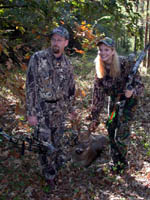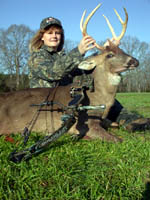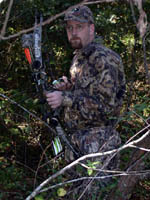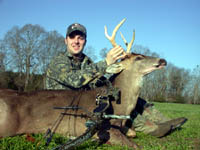
|
Features
|
|
|
|
Books
|
|
|
|
Fun & Games
|
|
|
|
Contact Us
|
|
|
John's Journal... Entry 218, Day 1
HOW TO TAKE HOT-WEATHER BUCKS
Hunt The Mast, The Birds And The Squirrels
 Editor's
Note: Biologists know the old adage that bucks don't move in hot weather
isn't true. Bucks have to feed, bed and get water, regardless of the temperature.
Bucks just move very little in hot weather. As the world experiences global
warming, we'll have to learn how to hunt for hot-weather bucks during
bow season. You can bag bucks with your bow in hot weather. The sportsmen
interviewed this week hunt primarily in the Deep South for at least three
or four months under hot-weather conditions each year and consistently
bag their bucks every season.
Editor's
Note: Biologists know the old adage that bucks don't move in hot weather
isn't true. Bucks have to feed, bed and get water, regardless of the temperature.
Bucks just move very little in hot weather. As the world experiences global
warming, we'll have to learn how to hunt for hot-weather bucks during
bow season. You can bag bucks with your bow in hot weather. The sportsmen
interviewed this week hunt primarily in the Deep South for at least three
or four months under hot-weather conditions each year and consistently
bag their bucks every season.
The first part of bow season in October, the temperature hovered around 90 degrees. Although the deer moved very little, the men I hunted with, Eddie Salter of Evergreen, Alabama, of Hunter's Specialties Pro Hunt Team and Tom McMillan of McPherson Archery in Brewton, Alabama, had hunted in this type of weather all of their lives.
 "If
you understand how to hunt the soft mast like the honey locust, you can
take deer during hot weather," Salter says. "During the first of bow season,
the deer often will feed on persimmons, one of their favorite food sources.
But you'll have more success if you'll hunt the persimmon trees at the
most-productive times." Salter suggests hunting over persimmons the morning
after a heavy rain or a heavy wind at night for the most success.
"If
you understand how to hunt the soft mast like the honey locust, you can
take deer during hot weather," Salter says. "During the first of bow season,
the deer often will feed on persimmons, one of their favorite food sources.
But you'll have more success if you'll hunt the persimmon trees at the
most-productive times." Salter suggests hunting over persimmons the morning
after a heavy rain or a heavy wind at night for the most success.
"The deer have learned that wind and rain will knock the persimmons off the tree, and they'll find the most persimmons then," Salter explains.
Deer also enjoy acorns during hot weather. However, most acorns don't fall until November and December in the South. But Larry Norton, a guide at Bent Creek Lodge near Jachin, Alabama, has learned how to hunt deer under acorn trees before the nuts fall.
 "Just
as the acorns begin to get ripe, squirrels and birds will go to the oak
trees and eat the acorns off the stems of the branches," Norton reports.
"The squirrels and the birds eat sloppily. They'll knock more nuts off
the tree than they actually eat. Often, a week or two before the nuts
should begin to fall, you can find deer hot spots by looking for squirrels
and birds feeding in the trees.
"Just
as the acorns begin to get ripe, squirrels and birds will go to the oak
trees and eat the acorns off the stems of the branches," Norton reports.
"The squirrels and the birds eat sloppily. They'll knock more nuts off
the tree than they actually eat. Often, a week or two before the nuts
should begin to fall, you can find deer hot spots by looking for squirrels
and birds feeding in the trees.
"Anytime I see four or five squirrels feeding in one tree or a flock of birds sitting in an acorn tree, I move in close and listen. If the birds and squirrels eat the nuts, I'll hear what sounds like rain falling from the trees. Then I move under the trees and check for deer droppings and empty acorn hulls to know the deer have fed there. Most of the time, I'll find two or three trails leading to a tree like this. I usually can set up a tree stand to hunt near the tree no matter which way the wind blows because the trails come from so many directions."
 However,
remember that deer don't like to move in the heat of the day. Hunt these
early nut trees or persimmon trees at first light or just at dark to see
the most bucks. Because of the concentration of a preferred food, deer
will pour into these areas. Set up your tree stand, and bag a buck with
your bow.
However,
remember that deer don't like to move in the heat of the day. Hunt these
early nut trees or persimmon trees at first light or just at dark to see
the most bucks. Because of the concentration of a preferred food, deer
will pour into these areas. Set up your tree stand, and bag a buck with
your bow.
TOMORROW: SALT, MINERAL LICKS AND PEA PATCHES
Check back each day this week for more about HOW TO TAKE HOT-WEATHER BUCKS ...
Day 1 - Hunt The Mast, The
Birds And The Squirrels
Day 2 - Salt, Mineral Licks And Pea Patches
Day 3 - Cut The Grass To Attract A Buck
Day 4 - Hunt The Water
Day 5 - Solve Hot-Weather Hunting Problems